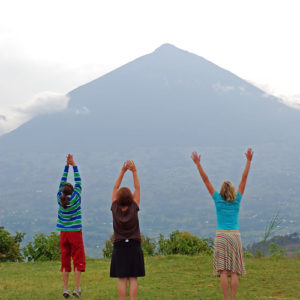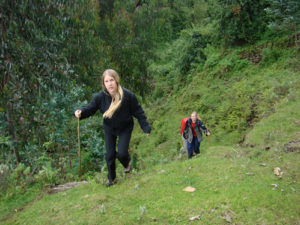Gorilla trekking is a very popular wildlife activity in Rwanda, Congo and Uganda. Tourists are interested in observing wild mountain gorillas because they behave and resemble humans. Each mountain gorilla is  worth about 65,000 US Dollars if you consider the total amount of money earned for gorilla permits in a year and divide by the number of habituated individual primates. The tourism money and their endangered status has forced the three governments to guard them jealously.
worth about 65,000 US Dollars if you consider the total amount of money earned for gorilla permits in a year and divide by the number of habituated individual primates. The tourism money and their endangered status has forced the three governments to guard them jealously.
Watching a group of mountain gorillas led by the dominant silverback can be very emotional and most people would want to experience it with close family/friends. A typical gorilla family consists of between 6 to 24 individuals headed by a dominant silverback. The silverback is very protective of his family but also very loving to the younger ones. In a typical gorilla group, there are also females, adolescents and infants (sometimes even twins). Observing a group of mountain gorillas would be excellent if done with family. Unfortunately, this is not always the case especially if it involves children.
Why children are not allowed to do gorilla trekking
The Wildlife Authorities in Uganda, Congo and Rwanda have set the minimum age for gorilla trekking to 15 years. This implies that children are not allowed to go for gorilla trekking. Children may not be able to remain calm when a gorilla charges. Mountain gorillas rarely charge but can do so if they consider trackers as a threat. A charging gorilla will back off if a tracker remains calm and lays low. A child may get too scared, scream or be forced to run because of the mighty bark of a gorilla. A charging gorilla will almost always chase after a running tourist.
 Children are still developing their immunity and are prone to transmittable diseases like flu/cough. Flu and cough can be transmitted to gorillas and the result can be very deadly. Children are also unpredictable. They may not be able to complete the activity if they feel tired. This is especially true in the Volcanoes National Park of Rwanda and Mgahinga National Park in Uganda. Gorilla trekking requires some level of fitness and determination to continue up to the end. In Rwanda, one has to deal with mountains and steep slopes which can be very tiring especially if a particular gorilla group is not close to the starting point. Mature travelers are more focused and mentally prepared to deal with the challenges (steep slopes, muddy trails, insects and thick forest) of tracking gorillas.
Children are still developing their immunity and are prone to transmittable diseases like flu/cough. Flu and cough can be transmitted to gorillas and the result can be very deadly. Children are also unpredictable. They may not be able to complete the activity if they feel tired. This is especially true in the Volcanoes National Park of Rwanda and Mgahinga National Park in Uganda. Gorilla trekking requires some level of fitness and determination to continue up to the end. In Rwanda, one has to deal with mountains and steep slopes which can be very tiring especially if a particular gorilla group is not close to the starting point. Mature travelers are more focused and mentally prepared to deal with the challenges (steep slopes, muddy trails, insects and thick forest) of tracking gorillas.
Children are also less likely to follow regulations for gorilla trekking. The gorilla trekking rules are meant to protect the primates and trackers. These include keeping a distance of at least 7 meters, following instructions from the park Guides, not littering the park, talking in low tones, not looking directly in the eyes of a gorilla and not attempting to touch a gorilla.
How to do Gorilla trekking with Kids
Despite the age restrictions for gorilla trekking, it is still possible to travel with the kids for gorilla trekking. In fact, if a child is 14 years and about to reach 15, they can still be allowed to do gorilla trekking in Bwindi National Park of Uganda. All you need to do is write a letter to the Uganda Wildlife Authority with information (age and photos) about the kid. The parent most accept responsibility in case anything happens during the trek. The child can only be allowed to track the gorillas when in the same group as the parent. If you have a child who is 14 years and are planning to take him/her for gorilla trekking, please contact office@silverbackgorillatours.com. We will help you get special authorization for the child.
In case a child is clearly too young for gorilla trekking, you can still travel with them (especially if you are also booked for other wildlife activities). As you go for gorilla trekking, hotel staff can take care of the kids and ensure that they are engaged when you are out in the forest. There are a variety of activities children can get involved in as their parents go out for gorilla trekking. The hotel staff or company Guide can take them for nature walks, visiting the nearby local schools or attending traditional dance performances. The nature walks are led by an experienced park Guide to look out for rare birds and butterflies. Parents can also track the primates in turns as one remains behind to take care of the children for a day.

